Fish Report for 3-20-2024
Novel parasite detected in trout at three Oregon fish hatcheries

by OR Department of Fish & Wildlife Staff
3-20-2024
Website
CORVALLIS, Ore.—ODFW's fish health lab has detected a novel parasite in sick rainbow trout that were raised at Klamath Falls, Rock Creek and Elk River hatcheries. The detection marks the first time this parasite has been associated with disease symptoms in Oregon's fish.
Late last year, ODFW fish health and hatchery staff noticed increased mortality in several raceways of rainbow trout at the three hatcheries. Staff from ODFW's fish health lab tested the fish for bacteria and viruses but did not detect any known pathogens. Hatchery staff treated the trout with two rounds of antibiotics and other supportive care but the fish did not respond.
To determine what was causing the fish to get sick, ODFW began working with Oregon State University's College of Veterinary Medicine and Department of Microbiology. They identified an unknown parasite within the blood vessels, gills, and kidney tissue of the affected trout. Preliminary genetic testing places this parasite as a Myxidium species in the class Myxozoa which includes over 2,400 parasitic organisms.
This parasite has a two-host life cycle. It first infects an invertebrate host such as an aquatic worm, then moves into the water where it infects fish, then leaves the fish to infect a worm again. Sometimes these parasites are associated with disease in the fish.
The parasite is similar to others previously identified in fish in Pacific Northwest. "While this parasite is thought to already exist in the Pacific Northwest region, it is the first time we have seen it associated with illness and mortality in fish in Oregon," said Dr. Aimee Reed, aquatic veterinarian and ODFW's senior fish pathologist.
The origins of the parasite are unclear. Due to infrastructure loss during the 2020 wildfires, Klamath Falls and Rock Creek hatcheries are currently unable to raise fish at their earliest life stages (the egg and alevin stage). The rainbow trout were hatched at Trask Hatchery in February 2023. They were transferred to Klamath Falls in June during their fry stage (when fish are about two inches long) and from there to Elk River and Rock Creek in the fall.
The parasite can infect the fish's kidney and urinary systems. Where spores can be excreted into water, they're available to continue their life cycle in more worms and more fish. Because of the risk of spreading the parasite, the fish exposed cannot be safely released into Oregon's waters.;
Symptoms of the parasite were seen in several raceways raising about 160,000 legal-sized rainbow trout (8 to10 inches). ODFW hatchery staff have disposed of these trout to stop the spread of the pathogen.
"This is a disappointing loss but allowing the parasite to spread could be much worse and put even more fish at risk," said Dr. Reed. "Situations like this are why Oregon's state hatcheries have vigorous biosecurity measures and monitoring programs.
ODFW hatcheries take many biosecurity measures to reduce the risk of bacteria, parasites or other disease-causing agents from spreading. Fish are raised in separate raceways and not comingled. Staff sanitize any equipment that comes into contact with water or fish including boots and nets. Ponds and raceways are also sanitized once a cohort of trout leave the facility.
ODFW's fish health services conduct monthly examinations at all hatchery facilities and test fish for bacteria, viruses and parasites and other illnesses.
Thanks to these biosecurity and sampling measures, the parasite was contained to just a few raceways at Klamath Falls, Elk River and Rock Creek hatcheries
Hatchery managers have identified approximately 104,000 surplus trout being raised at other hatcheries to cover most of what was lost. Altogether, ODFW's hatcheries raise and release about 3.8 million rainbow trout annually.
Trout stocking across the state will be slightly decreased to make up the shortfall, minimizing the effect on any one trout stocking. ODFW will update the trout stocking schedule when more details on final stocking numbers are available.
ODFW and OSU have secured a safe research laboratory for 500vof the infected trout so they can learn more about the parasite. They will work to further identify the exact myxozoan species and determine how and when it infected the fish and caused disease.
As the changing climate results in warmer rivers and conditions that favor pathogens, ODFW's fish health monitoring is becomingvincreasingly important as a first line of defense. The veterinarians and microbiologists within the program also conduct research, often in collaboration with OSU researchers, to ensure the Department is staying at thevcutting edge of fish health management.
"We know that high temperaturesvand low flows are more inviting for parasites like myxozoans to infect fishes," said Reed. "Climate change is causing exactly these conditions so it could be playing a role in why we are seeing this parasite now.
ODFW is also looking at howvhatchery infrastructure can be modified to adapt to the changing environment and improve fish health.
More Reports
OR Department of Fish & Wildlife Reports
for Friday, March 15thMiami River: Fishing conditions are good on the Miami River
Necanicum River: The Necanicum should be in good shape through the weekend
Nehalem River: The Nehalem has good catch-and-release opportunities for wild steelhead
Nehalem River- North Fork: The North Fork is slightly on the high side but has good color and is on the drop
Nestucca River: Should drop into great shape by the weekend
Three Rivers: Three Rivers should be dropping into shape
Wilson River: The Wilson is a little high still but is greening up and should be in prime shape tomorrow
Dexter Reservoir: May be increased fishing opportunity for warmwater game fish
Foster Reservoir: The first spring stocking will be in a couple of weeks
Santiam River ( North Fork) : River is currently running at around 3,200 cfs at the gauge in Mehama
Santiam River (South Fork): Currently flows are around 2,000 cfs at the Waterloo gauge
Campbell Reservoir: The reservoir is not frozen
Gerber Reservoir: The reservoir is 30 percent full
Klamath River - Upper - OR: Klamath River Fishing Report
Agate Lake: Agate Reservoir continues to rise and is now 100 percent full
Ben Irving Reservoir: Fishing will be picking up this week
Chetco River: The final two weeks of the season are here
Cooper Creek Reservoir: Trout fishing should be good
Coquille River: The North Fork Coquille River should be in good shape during the week
Diamond Lake: Diamond Lake is frozen over
Elk River: The few anglers fishing the river are finding steelhead are scattered throughout
Garrison Lake: Conditions are excellent for trout fishing
Plat I Reservoir: Plat I was overfull as of last week
Rogue River- Lower: Fishing has been good for both steelhead and Chinook when flows have been dropping
Rogue River - Middle: Should be in perfect shape by this weekend
Rogue River- Upper: Expect releases from the dam to increase by this weekend
Sixes River: Finally the river conditions look like they will be improving
Umpqua River: The mainstem Umpqua has been cold, high and muddy lately
North Umpqua River: The North Umpqua is still high, but conditions are improving
South Umpqua River : Conditions should start to improve
: Razor clamming reopens on Central Coast
ODFW Recreation Report

3-14-2024
Includes updates to fishing, crabbing and clamming John Day pool closes to sturgeon retention after March 14 Fishery managers project 94 percent...... Read More

Website Hosting and Design provided by TECK.net